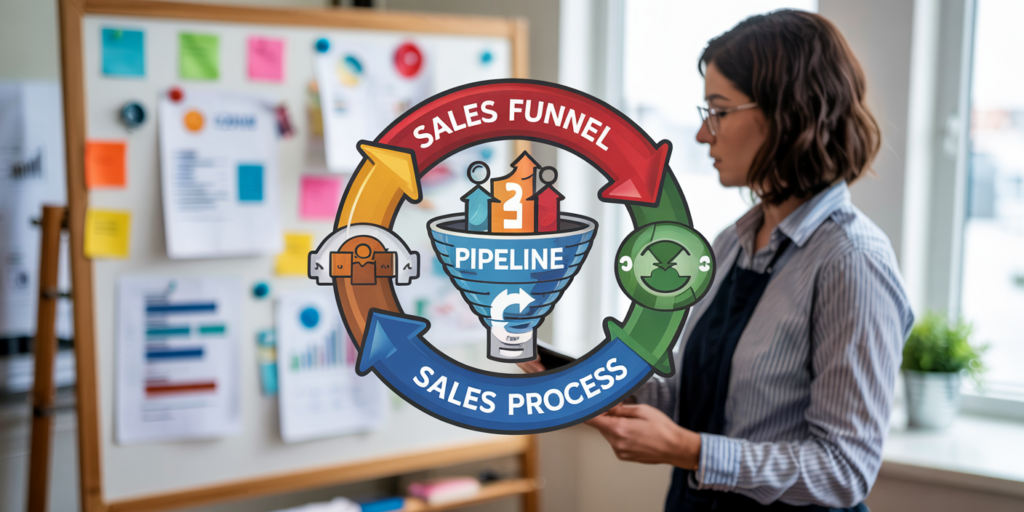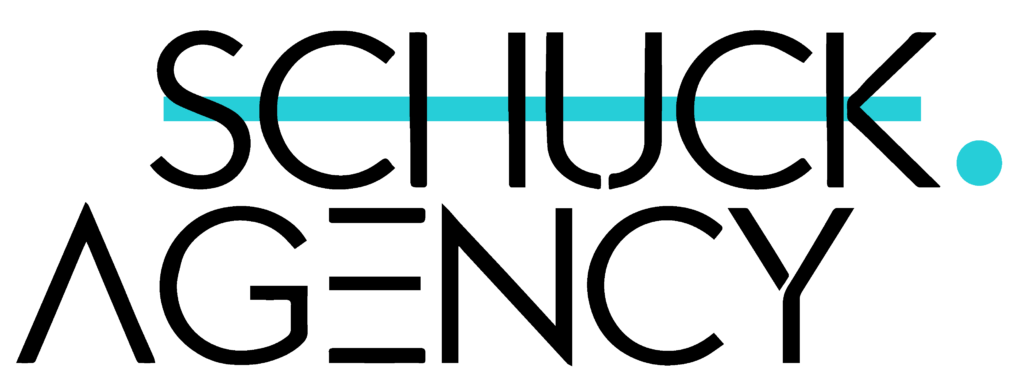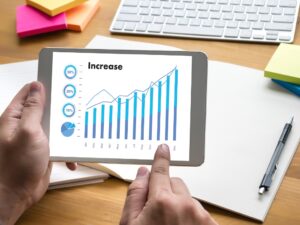
Your sales pipeline is NOT your sales funnel – and it’s hurting your revenue if you think it is. With so much jargon, it can be easy to blur the line between sales funnel vs sales pipeline vs a sales process.
BUT…these are NOT interchangeable tools. They’re pieces of your revenue puzzle that must work together.
Think your sales system is working? Ask yourself:
• Can you predict next quarter’s revenue accurately?
• Do you know precisely where deals get stuck?
• Is your team following a standardized process?
If you answer “no” to any of these, understanding the distinction between sales funnels, pipelines, and processes can transform your revenue operations. When properly differentiated and aligned, these three frameworks create a powerful system that drives predictable growth.
Let’s untangle this confusion once and for all.
> The Sales Funnel: Visualizing Conversion
A sales funnel represents the buyer’s journey from awareness to purchase, illustrated as a wide-to-narrow structure showing how prospects filter through each stage. Its primary purpose is conversion analysis.
The funnel exists to answer one critical question: Where are we losing potential customers?
Unlike other sales frameworks, funnels focus exclusively on conversion rates between stages. They quantify drop-off points and help identify where your sales approach needs refinement. A properly analyzed funnel reveals your most significant conversion obstacles.
Think of funnels as diagnostic tools:
• Measures your AUDIENCES behavior
• Track prospect movement stages
• Identify conversion bottlenecks
• Quantify drop-off points
But funnels have limitations. They treat all prospects equally and suggest a linear path that rarely matches reality. Modern buyers jump stages, circle back, and take unexpected routes to purchase decisions.
> The Sales Pipeline: Managing Opportunities

Your sales pipeline tracks individual opportunities through your selling stages. While funnels measure conversion percentages, pipelines manage actual deals with assigned values, probabilities, and timelines.
Think of your pipeline as inventory management for opportunities. It answers the following questions: What’s likely to close, when, and for how much?
Effective pipeline management requires regular cleaning, consistent qualification criteria, and accurate forecasting methodologies. When neglected, pipelines quickly become wishful thinking rather than reliable forecasting tools.
Pipelines manage actual deals and:
• Track YOUR actions and responses
• Sales forecast and success probabilities
• Deal progress and expected close dates
• Helps highlight opportunities and patterns
The most common pipeline mistake? Allowing opportunities to linger too long. Without strict movement criteria, sales pipelines bloat with zombie deals that distort forecasts and waste resources.
> The Sales Process: Standardizing Activities

Your sales process defines your team’s specific actions to move opportunities forward. While funnels and pipelines are visualization and management tools, your process is the actual playbook.
A robust sales process documents:
• Required activities at each stage
• Entry and exit criteria between stages
• Tools and resources for each activity
• Expected customer responses and objections
• Timing guidelines and escalation triggers
The process exists to create consistency and repeatability. By codifying what works, you transform selling from art to science.
Your process becomes your playbook. It defines:
• Your RECURRING actions
• Qualification steps and handoff protocols
• Sales cycle and timing guidelines
• Discussion framework and expected customer responses
• Proposal and close sequence
Organizations with clearly defined sales processes outperform those without them by wide margins. Yet many companies mistake having stages for having a process. Naming your pipeline stages isn’t enough. Each stage needs detailed activity guidelines.
> How They Work Together
The relationship between these three frameworks matters more than their differences:
Your sales process defines the activities that move opportunities through your pipeline, while your funnel measures how effectively those activities convert prospects at each stage.
When properly integrated, these systems create a feedback loop. Funnel analysis identifies conversion problems. Your process gets updated to address those problems. Your pipeline then implements and tracks the new approach.
These frameworks create a feedback loop:
• Processes move opportunities through pipelines
• Funnels measure conversion effectiveness
• Analysis helps you optimize processes
• Pipelines track the new approach

> Implementation Priorities
If building from scratch, develop these components in this order:
1. Create your sales process first. Document the activities that move prospects toward purchase.
2. Build your pipeline structure second. Define stages that align with meaningful milestones in your customer’s journey.
3. Implement funnel analytics last. Once your process and pipeline stabilize, measure conversion rates to optimize performance.
Many organizations do this backward. They obsess over funnel metrics without standardizing the activities that influence those metrics. Fix your process first, then measure its effectiveness.
> Beyond the Basics
As markets evolve, so should these frameworks. Modern sales organizations are adapting these concepts in several ways:
Funnels are becoming more flexible, acknowledging non-linear buying journeys. Pipelines now incorporate buying group consensus tracking, not just deal stages. Processes are increasingly dynamic, with AI suggesting the next best actions rather than rigid playbooks.
Organizations that see the greatest success don’t just understand these differences. They create tight integration between them, using each framework’s strengths to compensate for the other’s weaknesses.
The distinction between funnel, pipeline, and process isn’t academic. It’s the foundation of sales operations that consistently deliver predictable revenue growth.






